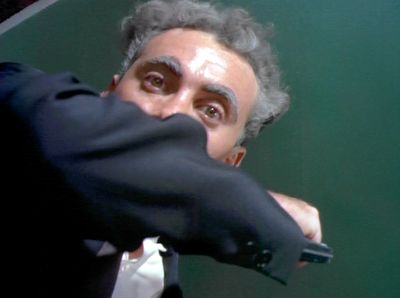What is an "exploitation film?" The term has been applied to movies of so
many different persuasions that it scarcely holds a meaning of its own
without further definition. Perhaps it involves the use of a current "hot"
issue--a promise that citizens concerned with the burning societal questions
of the day will find the film in question "must" viewing. Perhaps it
involves "forbidden" thrills being offered in the guise of serious
"adult" education. Or perhaps it involves a pledge to provide the viewer
with something they've never seen before--if they have what it takes to
handle it, naturally.
From 1959 through 1972, writer/producer/director Herschell Gordon Lewis
thoroughly explored every one of these avenues. His mission? To make films
that made money--for himself and his partners, or for others who hired him
out. And while cinematic "art" was the furthest thing from his mind, his
foresight enabled him to leave an indelible stamp on the film industry--as
the unquestioned "Godfather of Gore."
Lewis's no-nonsense approach resulted in a partnership with
producer/distributor David F. Friedman. While Friedman came from a
carnival background and was an well-versed veteran of the "roadshow" experience, Lewis
had worked as a television director and brought this experience to the
alliance. It was Friedman's Essanjay Films that distributed Lewis's
directorial debut, The Prime Time (a "reckless youth" drama notable as
actress Karen Black's first film). This was followed by such Lewis/Friedman
collaborations as Living Venus (a serious, well-crafted drama--starring
none other than Harvey Korman--which used the career of Hugh Hefner for
inspiration), the nudie comedy The Adventures of Lucky Pierre, and a
predictable string of nudist-camp epics.
But not even these could last. As so-called "mainstream" studios started
taking more and more advantage of a new societal permissiveness, the
innocent romps of Friedman, Lewis, and others quickly lost their drawing
power. Rather than follow anyone else's trend, the duo decided to move in a
completely different direction...and in 1963, the first full-fledged "gore"
film was unleashed on a completely unsuspecting public.

A homicidal maniac descends upon a victim in Blood Feast.
(© 1963 Box Office Spectaculars. All rights reserved.)
Blood Feast was simple in story and often laughable from an acting
standpoint. It was certainly no threat to the established classics of the horror
genre in this regard. But the selling point was unique: never before had
such lingering, full-color gore been displayed on any theater screen...let
alone in such quanitities as Blood Feast offered. The result? An
unqualified sensation--and the horror film genre would never be quite the same
again.
Lewis and Friedman parted company after their third gore epic (the "trilogy"
included Two Thousand Maniacs! and Color Me Blood Red), but both men remained
active in various "exploitation" circles. Lewis continued making films in
various genres through 1972 (most notably She-Devils on Wheels, The
Wizard of Gore, and The Gore Gore Girls), ultimately retiring from movies
and becoming a success in the world of direct marketing.
Today, the films of H.G. Lewis are more in demand than ever before.
Ironically, it may have been his detractors who sparked this attention: the
1980 Medved Brothers book The Golden Turkey Awards
nominated Lewis as "The Worst Director of All Time," utilizing graphic
descriptions of some of his most outrageous scenes. However, instead of creating scorn for Lewis's films, they created curiosity--and the video
boom of the 1980s quickly brought the Lewis/Friedman "Blood Trilogy" into a
new level of availability. A book on the director and his work quickly sold
out, becoming an instant collector's item; and Lewis himself soon became a
much sought-after interview subject and convention guest, as well as the
object of many a filmic tribute.
The year 2000 marks the debut of Lewis's work on DVD, as well as the
publication of a new "Films Of" book--created out of sheer necessity by
devoted fan Christopher Wayne Curry. Reviews of this volume and the first
five DVDs in a series brought to you by Image Entertainment and Something
Weird Video (itself named after a Lewis film!) follow. By all means, come
along...if you have what it takes!
NEXT PAGE »
Go to:
Introduction
A Taste of Blood (book review)
Blood Feast
Two Thousand Maniacs
Color Me Blood Red
A Taste of Blood
Something Weird
The Gruesome Twosome
She-Devils on Wheels
The Wizard of Gore
The Gore Gore Girls
ABOUT THE DVDs







